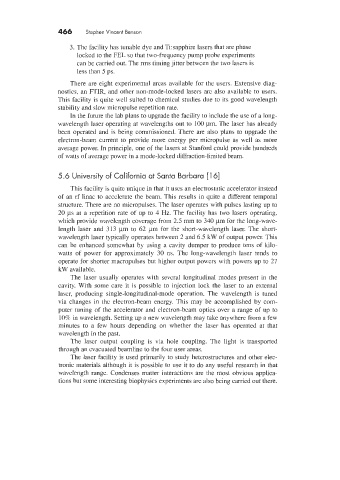Page 506 - Tunable Lasers Handbook
P. 506
466 Stephen Vincent Benson
3. The facility has tunable dye and Tisapphire lasers that are phase
locked to the FEL so that two-frequency pump probe experiments
can be carried out. The rms timing jitter between the two lasers is
less than 5 ps.
There are eight experimental areas ayailable for the users. Extensive diag-
nostics. an FTIR, and other non-mode-locked lasers are also available to users.
This facility is quite well suited to chemical studies due to its good wavelength
stability and slow micropulse repetition rate.
In the future the lab plans to upgrade the facility to include the use of a long-
wavelength laser operating at wavelengths out to 100 ym. The laser has already
been operated and is being commissioned. There are also plans to upgrade the
electron-beam current to provide more energy per micropulse as well as more
average power. In principle, one of the lasers at Stanford could provide hundreds
of watts of average power in a mode-locked diffraction-limited beam.
5.6 University of California at Santa Barbara [16]
This facility is quite unique in that it uses an electrostatic accelerator instead
of an rf linac to accelerate the beam. This results in quite a different temporal
structure. There are no micropulses. The laser operates with pulses lasting up to
20 ps at a repetition rate of up to 4 Hz. The facility has two lasers operating.
which provide wavelength coverage from 2.5 mm to 340 pm for the long-wave-
length laser and 313 ym to 62 pm for the short-wavelength laser. The short-
wavelength laser typically operates between 2 and 6.5 kW of output power. This
can be enhanced somewhat by using a cavity dumper to produce tens of kilo-
watts of power for approximately 30 ns. The long-wavelength laser tends to
operate for shorter macropulses but higher output powers with powers up to 27
kW available.
The laser usually operates with several longitudinal modes present in the
cavity. With some care it is possible to injection lock the laser to an external
laser, producing single-longitudinal-mode operation. The wavelength is tuned
via changes in the electron-beam energy. This may be accomplished by com-
puter tuning of the accelerator and electron-beam optics over a range of up to
10% in wavelength. Setting up a new wavelength may take anywhere from a few
minutes to a few hours depending on whether the laser has operated at that
wavelength in the past.
The laser output coupling is via hole coupling. The light is transported
through an evacuated beamline to the four user areas.
The laser facility is used primarily to study heterostructures and other elec-
tronic materials although it is possible to use it to do any useful research in that
wavelength range. Condenses matter interactions are the most obvious applica-
tions but some interesting biophysics experiments are also being carried out there.

